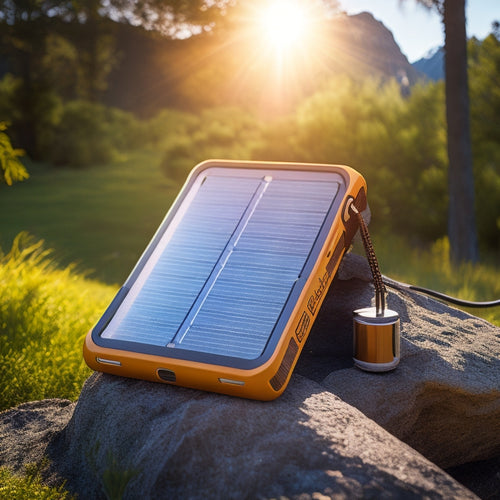
How to Calculate Home Energy Installation Costs
Share
To calculate home energy installation costs, you'll need to evaluate multiple factors, including upfront equipment and installation expenses, ongoing maintenance and fuel costs, and potential incentives like tax credits and rebates. Average residential solar panel system costs range from $15,000 to $30,000, with total system cost including installation and labor. Battery storage, inverter, and mounting costs, as well as additional system components, also impact the overall price. Accurately estimating costs requires assessing factors like system efficiency, energy yield, and local building codes. By understanding these components, you'll be able to make an informed decision about your energy independence project and uncover the full overview of your investment.
Overview
- Evaluate equipment quality, installation costs, and permits to determine upfront costs of solar panel systems.
- Consider factors influencing installation prices, including location, energy audit, government incentives, and local building codes.
- Calculate battery storage costs based on capacity, installation incentives, and energy needs assessment.
- Assess inverter and mounting costs, including efficiency ratings and material prices, to optimize system performance.
- Factor in additional system components expenses, such as monitoring tools, energy storage options, and backup power systems, to estimate total costs.
Understanding Solar Panel Costs
Your solar panel investment begins with understanding the upfront costs, a crucial step in determining whether this renewable energy source is right for your home.
You'll want to evaluate the total cost of the solar panel system, including equipment, installation, and permits. The type and quality of equipment, such as high-efficiency inverters and deep cycle batteries, play a significant role in overall system cost and performance System Size and Complexity.
Fortunately, there are solar incentives that can help offset these expenses, such as tax credits and rebates.
Additionally, various financing options are available, like loans and power purchase agreements, to help make solar energy more accessible.
Average Cost of Solar Panel Installation
The total cost of a solar panel installation varies widely, depending on system size, equipment quality, and local labor rates. On average, you can expect to pay between $15,000 and $30,000 for a residential solar panel system.
However, the total system cost includes installation and labor costs, which can add thousands to overall expenses. By considering cost calculation factors such as system efficiency and energy yield, you can make an informed decision about your investment.
With solar incentives and financing options, your out-of-pocket cost can be greatly reduced. The federal solar investment tax credit (ITC), for instance, allows you to claim 26% of the total cost as a tax credit.
Additionally, many states and utilities offer rebates and other incentives to encourage homeowners to go solar. By taking advantage of these programs, you can bring your installation cost down to $10,000 or less.
Factors Affecting Installation Prices
As you investigate the cost of a solar panel installation, it's important to understand the various factors that influence the final price tag. Your installation location, for instance, plays a significant role.
Installations in urban areas tend to be more expensive than those in rural areas due to higher labor costs and permitting fees. Conducting an energy audit energy assessment can help identify areas of energy inefficiency, allowing you to optimize your solar panel installation and reduce costs.
Government incentives, such as the Solar Investment Tax Credit (ITC), can also impact the cost. The ITC allows you to claim a tax credit of 26% of the total installation cost.
Additionally, local building codes, permitting requirements, and utility company policies can add to or subtract from the overall cost. Understanding these factors will help you better estimate the cost of your solar panel installation and make informed decisions about your energy investment.
Calculating Battery Storage Costs
One crucial aspect of home energy installation is calculating battery storage costs, which can greatly impact the overall expense of your solar panel system.
You'll need to evaluate the battery capacity required to meet your energy needs. A higher battery capacity means a higher upfront cost, but it also provides more backup power during outages.
Installation incentives, such as the federal solar investment tax credit, can help offset these costs. You can claim a credit of 26% of the total cost of your solar panel system, including battery storage.
Be sure to factor in these incentives when calculating your battery storage costs. By accurately estimating these costs, you can make informed decisions about your home energy installation and achieve greater energy independence.
Inverter and Mounting Costs Breakdown
Your solar panel system's brain and backbone - the inverter and mounting system - play a critical role in capturing and converting sunlight into usable electricity.
The inverter is responsible for converting DC power from the solar panels to AC power for your home. When selecting an inverter, consider its efficiency, which affects your system's overall performance. Look for an inverter with high efficiency ratings (95% or higher) to maximize energy output.
Mounting materials, including racking and tracking systems, secure your solar panels to your roof or ground. The cost of mounting materials varies depending on the type and quality of materials used.
On average, inverter costs range from $0.10 to $0.15 per watt, while mounting materials cost around $0.05 to $0.10 per watt. Make certain to factor these costs into your overall system budget to guarantee a successful and efficient energy installation.
Additional System Components Expenses
You'll also need to contemplate the costs of additional system components that can enhance your home energy installation's performance and functionality.
These may include system monitoring tools that track your energy production and consumption, energy storage options like batteries, and backup power systems that provide electricity during grid outages.
These components can add significant value to your installation, but their costs must be factored into your overall budget.
System Monitoring Tools
As solar panels generate electricity, system monitoring tools track the performance of your home energy installation, providing useful viewpoints to optimize energy production and identify potential issues. With these tools, you can access real-time data on your system's performance, receive alerts for any malfunctions, and even monitor your energy consumption. This data helps you identify areas for improvement, ensuring you get the most out of your investment.
| Monitoring Tool Features | Cost Range |
|---|---|
| Basic monitoring software | $100-$300 |
| Advanced monitoring with real-time data | $500-$1,000 |
| Detailed monitoring with energy consumption tracking | $1,500-$3,000 |
Energy Storage Options
Battery backup systems, an essential energy storage option, enable homeowners to store excess energy generated by their solar panels during the day for later use, providing backup power during outages and reducing reliance on the grid.
You'll need to evaluate the type of battery that suits your energy needs. Lead-acid batteries are a cost-effective option, while lithium-ion batteries offer higher energy efficiency and longer lifetimes.
You'll also need to factor in the size of your energy storage system, which depends on your energy usage and the amount of backup power you need.
When calculating the cost, assess the battery type, capacity, and installation costs. Energy storage options can add significant expenses to your overall installation cost, but they provide you with the freedom to control your energy usage and reduce your reliance on the grid.
Backup Power Systems
Your backup power system requires additional system components to secure seamless operation during outages and grid failures. A critical component is the generator, which comes in various types, including natural gas, propane, and diesel generators.
The type you choose will impact your overall costs. You'll also need to factor in installation permits, which vary by locality and can range from $500 to $2,000.
Additionally, you may need to install a transfer switch, which allows the generator to power your home during an outage. This can add another $500 to $1,000 to your total cost.
When calculating your backup power system costs, be certain to include these essential components to guarantee your system operates efficiently and safely.
Frequently Asked Questions
Can I Install Solar Panels on a Metal Roof?
You can install solar panels on a metal roof, leveraging its advantages like durability and ease of installation, but consider factors like panel weight, roof pitch, and sealant compatibility to guarantee a secure and efficient setup.
Do Solar Panels Work During a Power Outage?
Your solar panels are like a sleeping giant, waiting to be released - but during a power outage, they won't function unless you have a battery storage system; invest in outage preparedness to guarantee energy independence.
Are Solar Panels Resistant to Hail Damage?
You're wondering if solar panels can withstand hail damage. Rest assured, most solar panels are designed to resist hail impact, boasting impressive solar durability ratings, with some even certified to endure impacts of up to 1-inch hailstones at 50 mph.
Can I Add Solar Panels to an Existing System?
You can add solar panels to an existing system, but first, you'll need to guarantee solar panel compatibility and assess your existing system's upgrade potential, considering factors like inverter capacity and panel mismatch effects.
Do Solar Panels Increase My Property Taxes?
You'll likely see a property tax increase, but it's often offset by the solar investment benefits, such as increased property value and federal tax credits, which can reduce your overall tax liability and enhance your financial freedom.
Ready to Buy
As you finalize your home energy installation, it's crucial to tally up the total costs. The theory that solar panels pay for themselves over time holds true, but only if you accurately calculate the upfront investment. By considering the average cost of installation, factors affecting prices, battery storage, inverter and mounting costs, and additional system components, you'll have a precise estimate. Crunch the numbers, and you'll find that a well-planned solar energy system can indeed provide long-term savings and energy independence.
Related Posts
-

How to Achieve a Zero-Waste Lifestyle for a Greener Tomorrow
To achieve a zero-waste lifestyle, start by adopting the principles of refusing, reducing, reusing, and recycling. Sw...
-

Top 10 Off Grid Camping Gear Must-Haves
When you're off-grid camping, the right gear is crucial for a smooth expedition. Start with a durable, weather-resist...
-

Fastest Solar Chargers for Emergency Power
When choosing the fastest solar chargers for emergency power, you need to focus on features like rapid charging capab...


